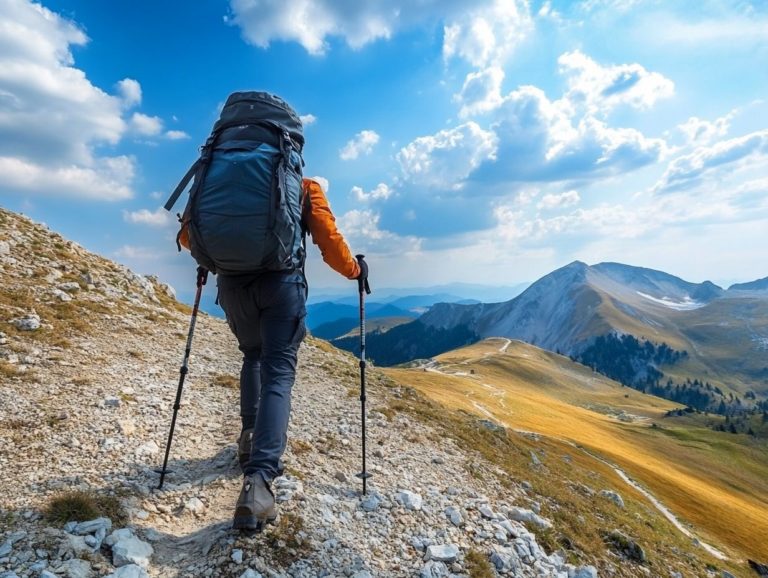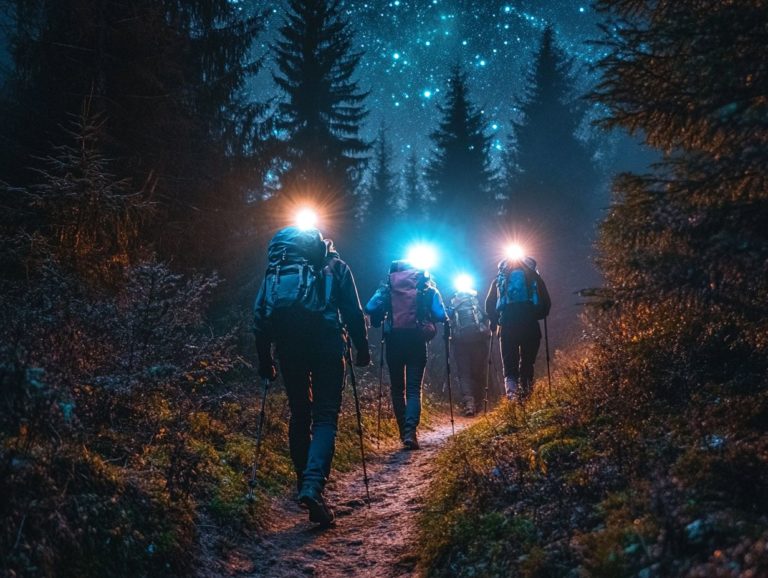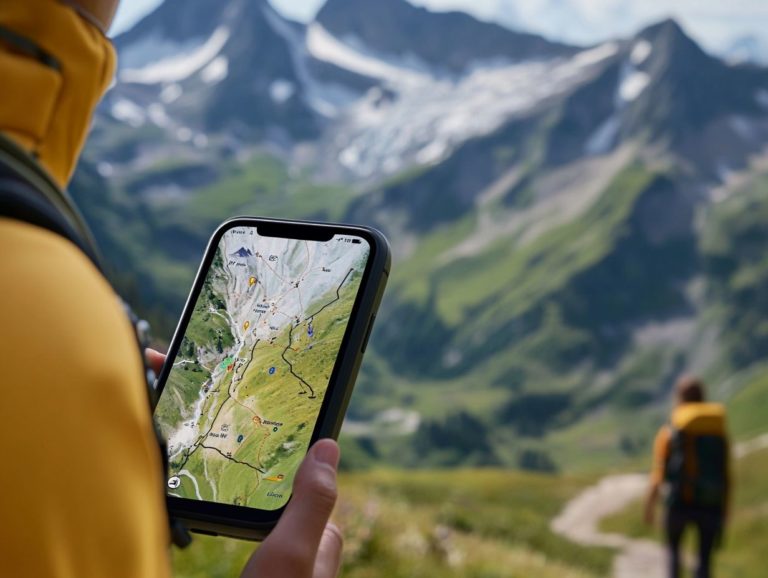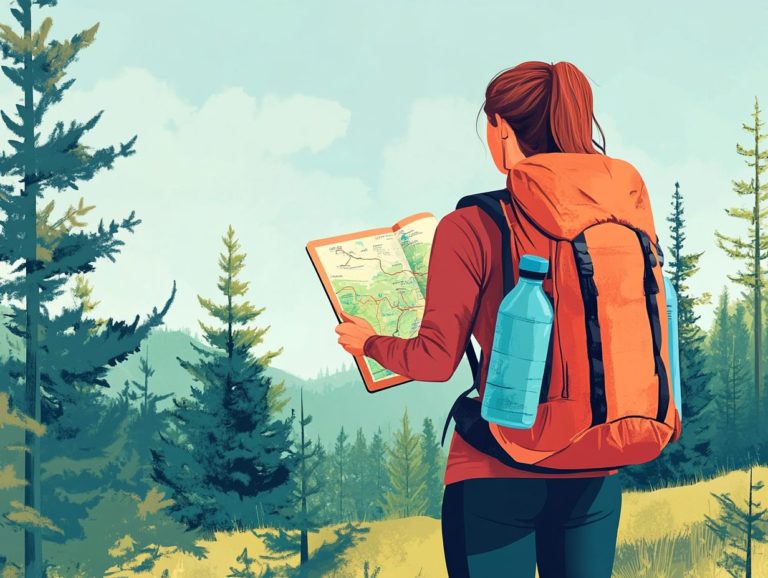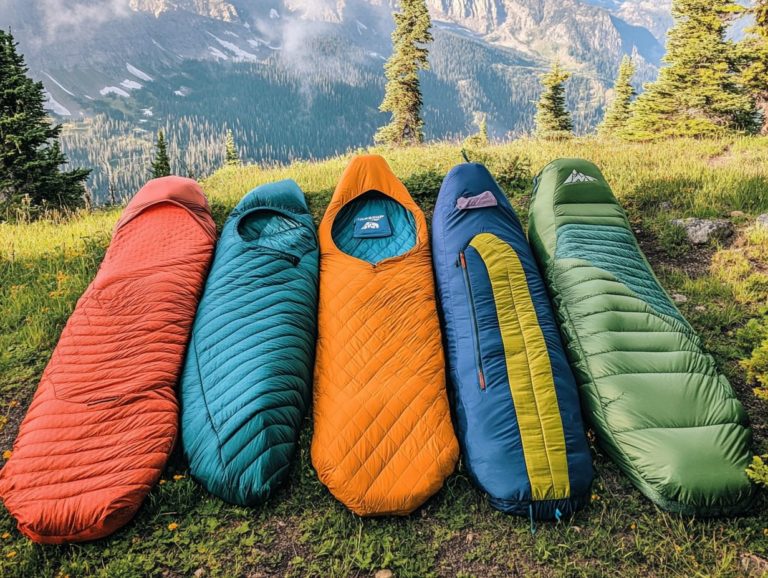The Best Gear for Cross-Country Hiking
Planning a cross-country hike? The gear you choose can truly elevate your adventure!
From durable hiking boots to essential navigation tools, each piece of equipment is vital for ensuring your safety and enjoyment along the trail.
This article outlines must-have items for a successful journey and optional gear that can enrich your experience.
You ll find tips to avoid common mistakes and choose the best gear to supercharge your hiking adventures!
Contents
- Key Takeaways:
- 1. Comfortable and Durable Hiking Boots
- 2. Lightweight and Breathable Clothing
- 3. Hydration System and Water Bottles
- 4. Navigation Tools
- 5. First Aid Kit
- 6. Multi-Tool or Pocket Knife
- 7. Sun Protection Gear
- 8. Shelter and Sleeping Gear
- 9. Cooking and Eating Utensils on Your Hiking Gear List
- 10. Bear Spray or Other Animal Deterrents
- 11. Emergency Communication Device
- 12. Trekking Poles
- 13. Insect Repellent
- 14. Portable Power Bank
- 15. Personal Items and Toiletries
- What Are the Essential Items for Cross-Country Hiking?
- Frequently Asked Questions
- What is the best type of backpack for cross-country hiking?
- Are hiking boots or trail running shoes better for cross-country hiking?
- What type of clothing is recommended for cross-country hiking?
- How important is a good quality water bottle for cross-country hiking?
- What type of navigation equipment should I bring for cross-country hiking?
- How can I protect myself from the elements while cross-country hiking?
Key Takeaways:
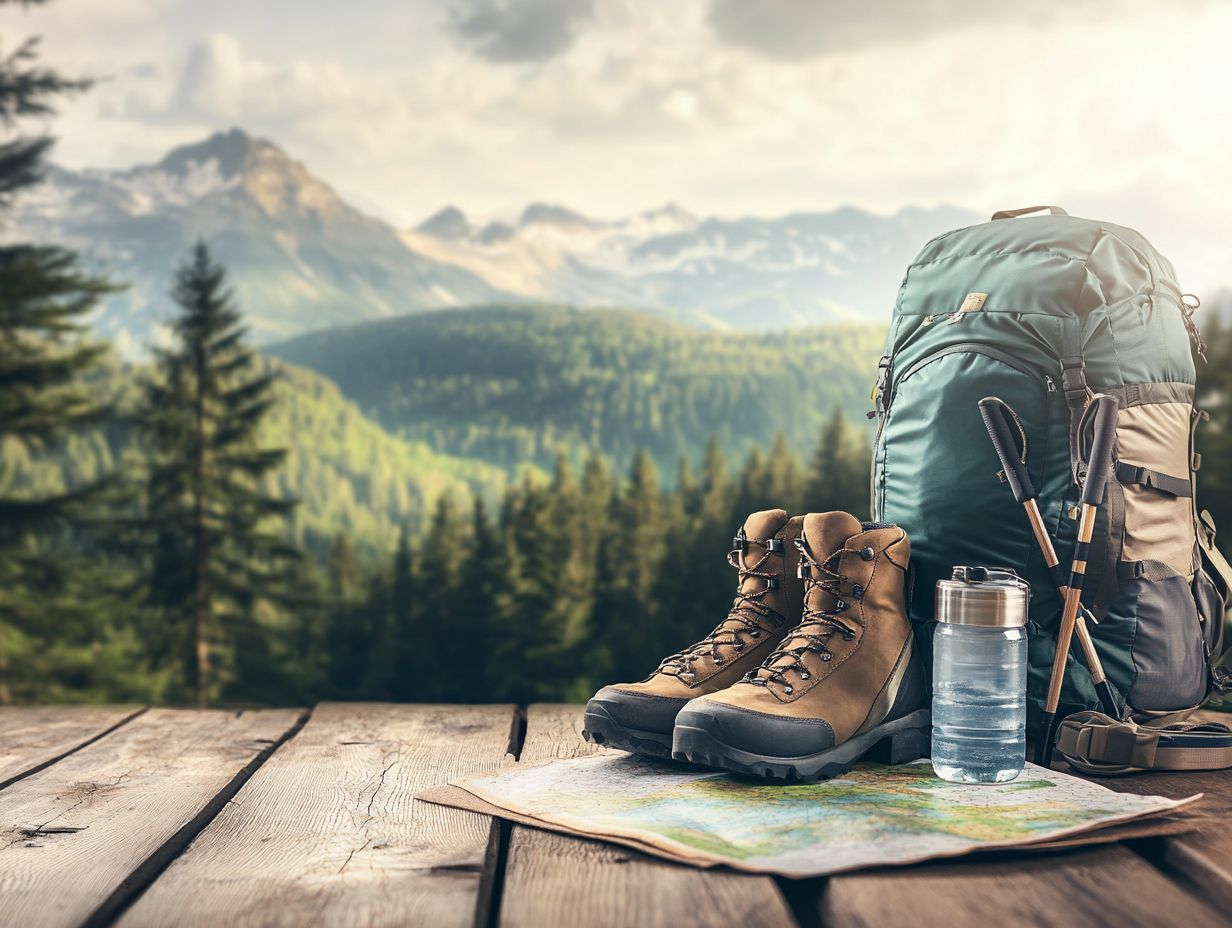
- Comfortable and durable hiking boots are essential for a successful cross-country hike.
- Lightweight and breathable clothing helps prevent overheating and allows for easy movement on the trail.
- A proper hydration system, including water bottles, is crucial for staying hydrated during a long hike.
1. Comfortable and Durable Hiking Boots
Investing in comfortable and durable hiking boots is essential for any outdoor enthusiast. The right hiking boots boost your experience and keep you safe on all terrains.
Understanding the features that make a solid hiking boot can significantly enhance your performance and enjoyment on the trail.
With countless options available, including unsponsored gear and tested hiking gear lists, you can find the perfect pair tailored to your needs, whether you re conquering rugged trails or enjoying a leisurely nature stroll.
Pay close attention to waterproof materials that will keep your feet dry in wet conditions. Adequate support helps prevent fatigue and injury on longer hikes, and a good grip is non-negotiable. Seek boots with a durable outsole for traction on slippery or uneven surfaces.
Brands like Merrell, Salomon, and Keen are known for innovative designs that cater to diverse hiking demands.
Don t underestimate the importance of a proper fit trying them on is crucial. Consider the size and width that accommodates your foot shape; this can make all the difference on a challenging trek.
2. Lightweight and Breathable Clothing
Choose lightweight and breathable clothing for every outdoor adventure! It helps regulate your body temperature and wicks away moisture, keeping you comfortable throughout your hike.
Whether you select hiking essentials for the sweltering summer sun or cold-weather gear like the Patagonia Nano Puff, the right attire allows you to focus on the journey ahead without discomfort or distraction.
Moisture-wicking fabrics, such as polyester and nylon, are ideal for base layers. They draw sweat away from your skin, minimizing chafing and ensuring you stay dry.
For insulation, consider materials like merino wool and synthetic fibers, which provide warmth without the bulk, making them perfect for layering in unpredictable weather.
Mastering layering techniques is crucial! A typical approach might begin with a moisture-wicking base layer, followed by an insulating mid-layer, and topped off with a waterproof outer shell. Brands like Columbia and North Face offer reliable options, ensuring you have the protection and comfort needed for any hiking scenario.
3. Hydration System and Water Bottles
Staying hydrated is vital for your hiking experience. Investing in a reliable hydration system, such as a water bladder that allows for hands-free hydration, or high-quality water bottles can truly elevate your adventure on long trails or challenging hikes. When you utilize tools like the Sawyer water filter, you not only gain access to safe drinking water but also make it easier to stay hydrated during your outdoor excursions.
It s important for you to explore the various options available. Each choice has its unique advantages depending on the nature of your hike. For example, if you’re venturing into remote areas, it s wise to plan your hydration strategy by identifying potential water sources along your route. Incorporating portable filters can significantly lighten your load while providing peace of mind.
Make it a habit to sip water regularly rather than waiting until you’re thirsty. This practice helps maintain your performance and energy levels throughout the trek.
Effective navigation is crucial for your hiking adventures. Combining technology with classic tools will elevate your experience in the wilderness. Smartphone navigation apps can provide real-time positioning and route guidance, while devices like the Garmin GPSMAP 67 are ideal for serious treks. Carrying paper maps as a backup is a savvy move, ensuring you re never at a loss during your journey.
Each of these navigation tools has its strengths and weaknesses. For instance, GPS devices are typically accurate and reliable, even in remote areas, but they depend heavily on battery life and may struggle under dense tree cover. Smartphone apps often feature user-friendly interfaces and boast a wealth of trail options, but they can drain your battery quickly or become less effective when signal strength wanes. Traditional maps, while always dependable, require solid navigation skills to interpret correctly.
Integrate these options to enhance your hiking experience. Rely on GPS for initial navigation, utilize smartphone apps for supplementary information, and keep paper maps handy as a reliable fail-safe.
5. First Aid Kit
A well-stocked first aid kit is essential for every hiking adventure! It provides peace of mind and safety as you traverse those remote trails, giving you the power to respond effectively to any injuries or emergencies that may arise. Your emergency kit should include basic supplies and specialized items tailored to your unique hiking needs, ensuring you re fully prepared for whatever comes your way.
For instance, don t forget to pack adhesive bandages for pesky cuts and scrapes, antiseptic wipes to keep wounds clean, and gauze pads for deeper injuries. Adding pain relievers and blister treatment supplies can help you tackle common trail ailments with ease.
Depending on the duration and location of your hike, consider enhancing your kit with essentials like:
- Pack a snake-bite kit.
- Include allergy medications.
- Add a splint for serious injuries.
By customizing your first aid kit to fit the specific environment and potential hazards you might encounter, you can elevate your safety and fully embrace the joy of exploring the great outdoors.
6. Multi-Tool or Pocket Knife
A multi-tool or pocket knife is an essential addition to your hiking gear. It offers a range of functions that can be invaluable in unexpected situations along the trail. Whether you need to cut rope, open packages, or make small repairs, having the right tool at your side enhances your hiking experience and instills a sense of preparedness.
When you’re selecting the perfect hiking companion, consider features like weight every ounce matters during those long treks. Durability is crucial; tools crafted from high-quality materials can withstand the demands of outdoor adventures, ensuring they won t fail you when the going gets tough.
Specialized functions such as pliers, screwdrivers, and bottle openers can significantly increase your efficiency, allowing you to tackle a wider array of tasks without lugging around multiple items. A thoughtfully chosen multi-tool or pocket knife can be a game changer, streamlining your gear and providing peace of mind as you embark on your journey ahead.
7. Sun Protection Gear
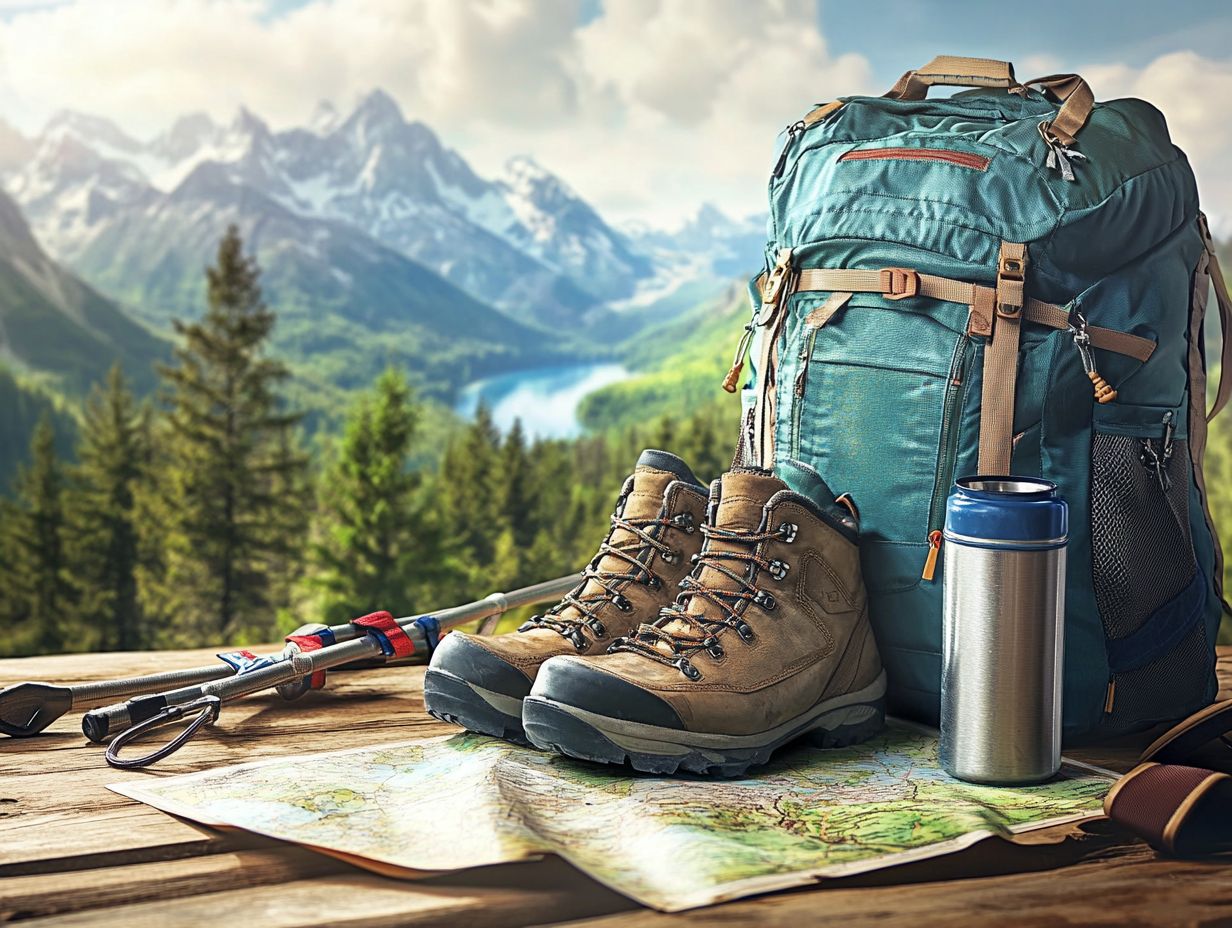
Sun protection gear is a critical part of your hiking kit, shielding you from harmful UV rays and ensuring a safer, more enjoyable outdoor experience. Whether you opt for high SPF sunscreen, a wide-brimmed hat, or UV-blocking clothing, safeguarding yourself from the sun should always be a priority.
Buying good UV-blocking sunglasses is a smart move. They protect your eyes from glare and mitigate long-term damage, enhancing visibility on bright trails. When planning your hikes, incorporate these protective items into your overall strategy.
Proper sun safety prevents sunburn and reduces the risk of heat exhaustion, a condition caused by prolonged exposure to heat, leading to fatigue and weakness. Regularly apply sunscreen, choose a hat with a neck flap for added coverage, and wear light, breathable fabrics that repel UV rays.
By thoughtfully packing these essentials, you can fully enjoy your outdoor experiences without worrying about sun-related health concerns.
8. Shelter and Sleeping Gear
The right shelter and sleeping gear make your adventure comfortable and safe. For a multi-day hike, having essential gear ensures both comfort and safety. Think lightweight tents, weather-appropriate sleeping bags, and cold-weather gear that provide insulation and cushioning. These elements will make your experience enjoyable after a long day on the trail.
As you explore options, weigh the merits of traditional tents, versatile hammocks, or bivy sacks (a lightweight sleeping bag cover), each with its unique advantages. For example, a two-person tent is ideal for a trek through a damp forest, while a hammock offers a breezy alternative, perfect for warmer climates with plenty of tree cover.
Sleeping bags are tailored for specific temperature ranges for different hiking conditions. A three-season bag (suitable for spring, summer, and fall temperatures) is generally sufficient for most moderate climates. Specialized cold-weather models, like the Patagonia Nano Puff, are invaluable in subzero conditions. Having the right gear is essential for enhancing your hiking experience and ensuring safety when the elements are challenging.
9. Cooking and Eating Utensils on Your Hiking Gear List
Having the right cooking and eating utensils is crucial, especially if you plan to whip up meals on the trail. These tools will transform your hiking meals into delicious adventures!
When selecting these items, prioritize options that are lightweight and compact to maximize your pack space. Consider portable stoves that run on propane or canister fuel; they offer versatility and quick heating, allowing for fast meal prep after a long day of hiking. Cookware designed specifically for backpacking, like aluminum or titanium pots, is durable yet easy to carry.
Look for utensils that serve multiple purposes, such as sporks or collapsible measuring cups, which are essential for smart cooking on the trail and save weight and space.
By investing in these specialized items, you can find the perfect balance between culinary delight and practicality while navigating the great outdoors.
10. Bear Spray or Other Animal Deterrents
Safety while hiking hinges on your preparation for potential wildlife encounters, which can be mitigated with bear spray and other animal deterrents. This makes bear spray or other animal deterrents essential components of your hiking gear.
Understanding how and when to deploy these tools is crucial for mitigating risks and enhancing your outdoor experience, particularly in areas known for bear activity. As you navigate these regions, maintaining awareness of your surroundings is vital.
In your hiking gear list, consider including the Garmin inReach Mini, as wildlife can appear when you least expect it. Carrying bear spray isn t merely about having it on hand; mastering its proper usage can make a big difference in emergencies.
Ensure that the spray is easily accessible don’t tuck it away in your backpack. Take the time to practice using it, so you’re ready when it truly matters.
Making noise during your hike can help alert animals to your presence, diminishing the likelihood of surprise encounters. Sticking to marked trails and hiking in groups during daylight hours further reduces the risks associated with wildlife interactions.
By taking these precautions, you can enjoy your hiking adventures with greater peace of mind.
11. Emergency Communication Device
An emergency communication device, like the Garmin inReach Mini, is an essential tool for any hiker. It offers a reliable way to call for help when you find yourself in need while exploring remote areas.
This device keeps you safe when hiking alone and keeps you connected with loved ones, providing peace of mind throughout your outdoor adventures.
Beyond satellite phones, options such as personal locator beacons (PLBs) (devices that help you signal for help if you’re in trouble) and two-way messengers can be lifesavers for solo hikers. These devices significantly contribute to your safety, especially in areas where cell coverage is often spotty.
Rely on your Garmin GPSMAP 67, allowing you to send distress signals or update family and friends on your status. To fully leverage these technologies, it s important to familiarize yourself with how they operate, ensuring you re prepared with tested hiking gear before you head out.
Make sure to properly test all functions and keep those batteries charged. A lightweight USB charger is essential for smartphone navigation.
Keep in mind that both satellite phones and PLBs have their own limitations and costs. Therefore, selecting the right device tailored to your individual needs and adventures is absolutely vital.
12. Trekking Poles
Incorporating trekking poles into your hiking gear list can significantly enhance your stability and reduce strain on your joints. This makes them an invaluable tool for both seasoned hikers and beginners alike.
Brands like Black Diamond offer a range of trekking poles designed to withstand various terrains, ensuring you have the support and balance needed to navigate challenging trails.
Using these poles can dramatically decrease fatigue, allowing you to tackle longer distances without the usual exhaustion. When selecting the right trekking poles, consider several essential features.
Opt for lightweight options to minimize fatigue, and look for adjustable lengths that accommodate different terrains and your personal height, ensuring comfort throughout your hike.
Grip comfort is vital; ergonomic designs in trekking poles improve grip comfort and provide a secure hold, reducing the risk of blisters during extended outings.
Ultimately, choosing the right trekking poles can transform your hiking experience, promoting a sense of confidence and adventure as you explore the great outdoors. Gear up with the right tools today and hike with confidence!
13. Insect Repellent
Insect repellent spray is a critical companion, just like a Sawyer water filter is essential for hydration during your hiking adventures. This is particularly important in the warmer months when bugs can turn from minor nuisances into genuine health risks without proper insect repellent. By choosing the right insect repellent, you can immerse yourself in the beauty of the outdoors without the persistent annoyance of swarming mosquitoes and other pests.
These sprays also offer more than comfort; they provide vital protection against insect-borne diseases like Lyme disease and West Nile virus. You ll find a variety of insect repellents available on the market, ranging from natural oils such as citronella and tea tree, to synthetic formulas containing DEET or picaridin.
When selecting an effective spray, it s essential to consider factors like the specific insect threats in your area, the duration of your activity, and any skin sensitivities you might have. Applying the repellent evenly on exposed skin and clothing and reapplying as recommended can significantly boost its effectiveness. This ensures you remain safe and bite-free throughout your outdoor escapades.
14. Portable Power Bank
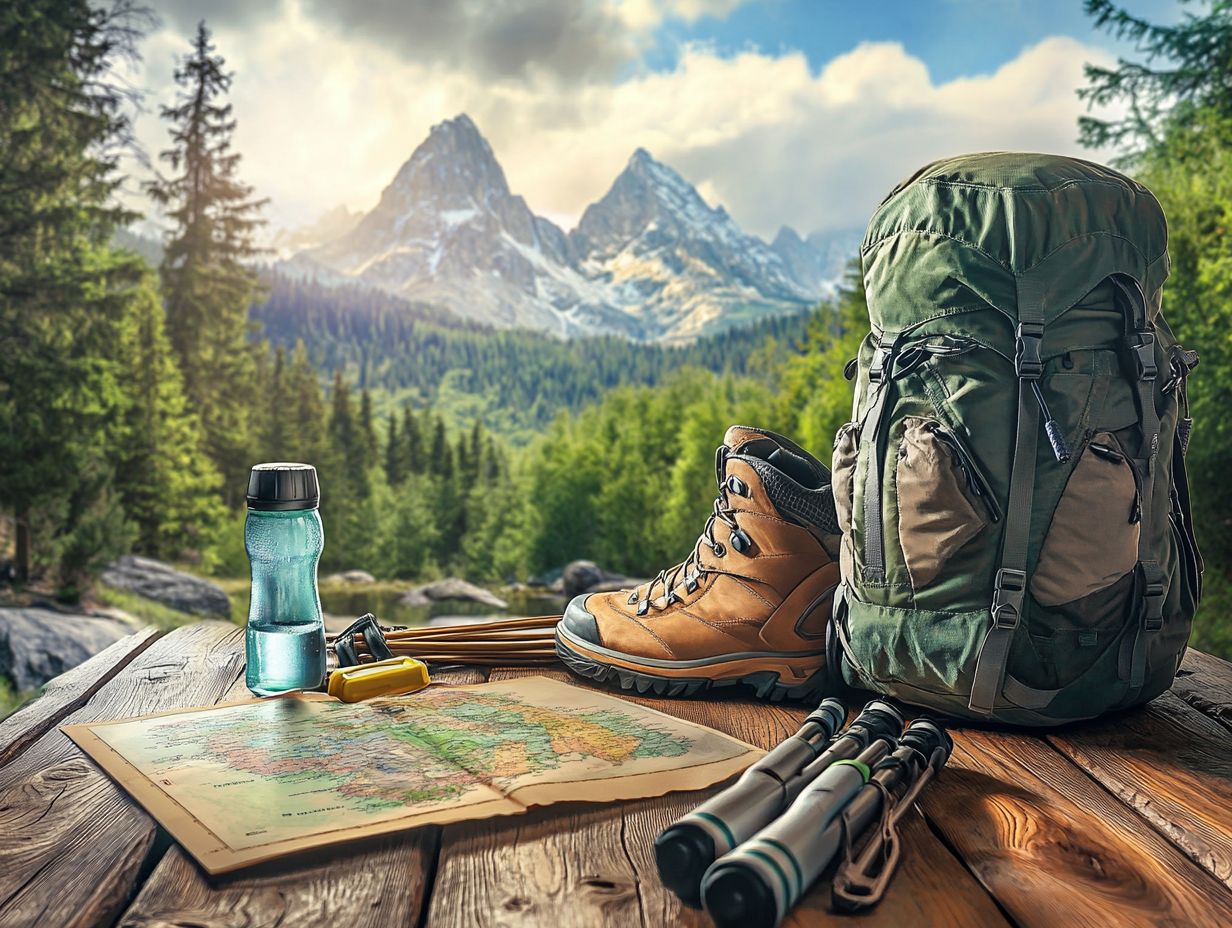
A portable power bank is an absolute must-have for the modern hiker. It allows you to charge your devices on the go, ensuring you stay connected during all your outdoor adventures. By opting for a lightweight USB charger, you won t feel weighed down while enjoying the essential functionality needed to keep your smartphone and navigation tools powered throughout your journey.
In the unpredictable embrace of nature, having a fully charged device can make the difference between a safe return and a detour you didn t plan for. When you re out hiking, reliable navigation becomes crucial, especially as trails fade and unexpected emergencies can crop up.
Choose a power bank that s water-resistant, has multiple charging ports, and offers high capacity these features are game-changers for your adventure! For short day hikes, a compact option may suffice, but if you’re venturing on extended treks, a more robust model with solar capabilities could be your best bet, ensuring you have an uninterrupted power supply even off the grid.
15. Personal Items and Toiletries
Carrying personal items and toiletries is often an afterthought in your hiking gear list. Yet having them on hand can significantly enhance your comfort and hygiene while on the trail. Bring essentials like biodegradable soap, a toothbrush, and a small towel to help maintain cleanliness and feel refreshed during your adventure.
Including items such as hand sanitizer, a compact toilet kit, and hygienic wipes is wise; they effectively prevent the spread of germs after handling gear or preparing meals. A reliable sunscreen and lip balm are essential for shielding yourself against sunburn, while insect repellent will keep those pesky bugs at bay.
To ensure you re thoroughly prepared, consider crafting a checklist of items like:
- A small first-aid kit
- Toilet paper
- Personal medications
These essentials boost your confidence and keep you comfortable in nature.
What Are the Essential Items for Cross-Country Hiking?
Cross-country hiking requires proper planning and the right gear for a safe and enjoyable adventure. Knowing which essentials to pack can enhance your journey.
- A dependable backpack is a must for comfortably carrying your gear. Clothes that keep you dry help regulate your body temperature in unpredictable weather.
- Investing in sturdy hiking boots provides essential support and traction, minimizing the risk of injury on uneven terrain.
A well-stocked first aid kit is critical for addressing minor injuries swiftly. Navigational tools, such as a compass and a reliable GPS device, can keep you on course, highlighting the importance of preparation for a successful hike.
What Are Some Optional but Useful Gear for Cross-Country Hiking?
While essential items are necessary for cross-country hiking, optional gear options can enhance your experience on the trail. These items may not be critical, but they can provide added comfort, convenience, and safety, making your journey more enjoyable.
For instance, a high-quality sleeping pad can transform your night’s rest, offering insulation and comfort that aids in recovery for the next day’s trek. Lightweight trekking poles help maintain balance and reduce strain on your joints, especially during steep descents.
Portable water filters allow you to refill your supplies safely, ensuring you stay hydrated without the burden of extra bottled water.
If you appreciate a touch of luxury, a compact camp chair can elevate your breaks, making them more enjoyable. A weather-resistant pack with ample organizational pockets facilitates easier access to your gear while keeping everything secure and tidy. Together, these options make outdoor adventures genuinely pleasurable.
How Can One Determine the Best Gear for Their Specific Hiking Needs?
Determining the best gear for your hiking needs involves considering various factors, such as the terrain, duration, and climate of your hike. By understanding these elements and exploring hiking gear options, you can make informed choices for successful and enjoyable adventures.
Think about your comfort to ensure a great hike. Whether you’re navigating rocky paths, braving unpredictable weather, or embarking on long-distance treks, the right equipment makes all the difference.
Exploring materials, reading reviews, and trying out gear at local outdoor shops can offer invaluable insights. This approach ensures that the gear fits perfectly and allows you to test its functionality in real-world scenarios.
Ultimately, evaluating these factors enhances both your safety and enjoyment on the trails.
What Are Some Common Mistakes to Avoid When Choosing Hiking Gear?
When selecting hiking gear, be aware of common mistakes that can impact your comfort and safety. Understanding pitfalls like choosing ill-fitting footwear or overlooking weather conditions enables you to make informed decisions.
A frequent misstep is purchasing equipment solely based on brand reputation instead of focusing on functionality and fit. A well-known brand may catch your eye, but not all products are created equal. What works for one person may not suit you at all.
Neglecting to test gear before heading out can cause discomfort or injury. To avoid these errors, prioritize trying on gear in stores, paying close attention to reviews and testimonials, and exploring alternative brands that may offer high-quality, budget-friendly options.
Investing time in thoughtful choices will yield rewards in the long run, transforming your hikes into enjoyable adventures.
Ready to hit the trails? Start packing your essential gear today!
How Can Proper Gear Enhance the Cross-Country Hiking Experience?
Utilizing the right gear can truly elevate your cross-country hiking experience. It provides comfort, safety, and efficiency throughout your journey.
From selecting the ideal footwear to employing advanced navigation tools, having the appropriate equipment allows you to immerse yourself in the breathtaking scenery and challenges of the trail. This way, you can enjoy the adventure without the distraction of discomfort or potential hazards.
High-quality socks can make a huge difference don t settle for less! Investing in sweat-proof, fast-drying socks prevents blisters and keeps your feet comfortable, allowing you to maintain your energy levels over longer distances.
A durable and lightweight backpack will help, too. Look for one with ergonomic straps that evenly distribute weight, minimizing strain on your back and shoulders.
Let s not overlook the benefits of GPS devices or smartphone apps. These tools offer precise trail information and enhance your safety, allowing you to navigate unfamiliar terrains with confidence.
Real-life examples clearly demonstrate how thoughtful gear selection can transform a strenuous trek into a more enjoyable and rewarding adventure.
Frequently Asked Questions
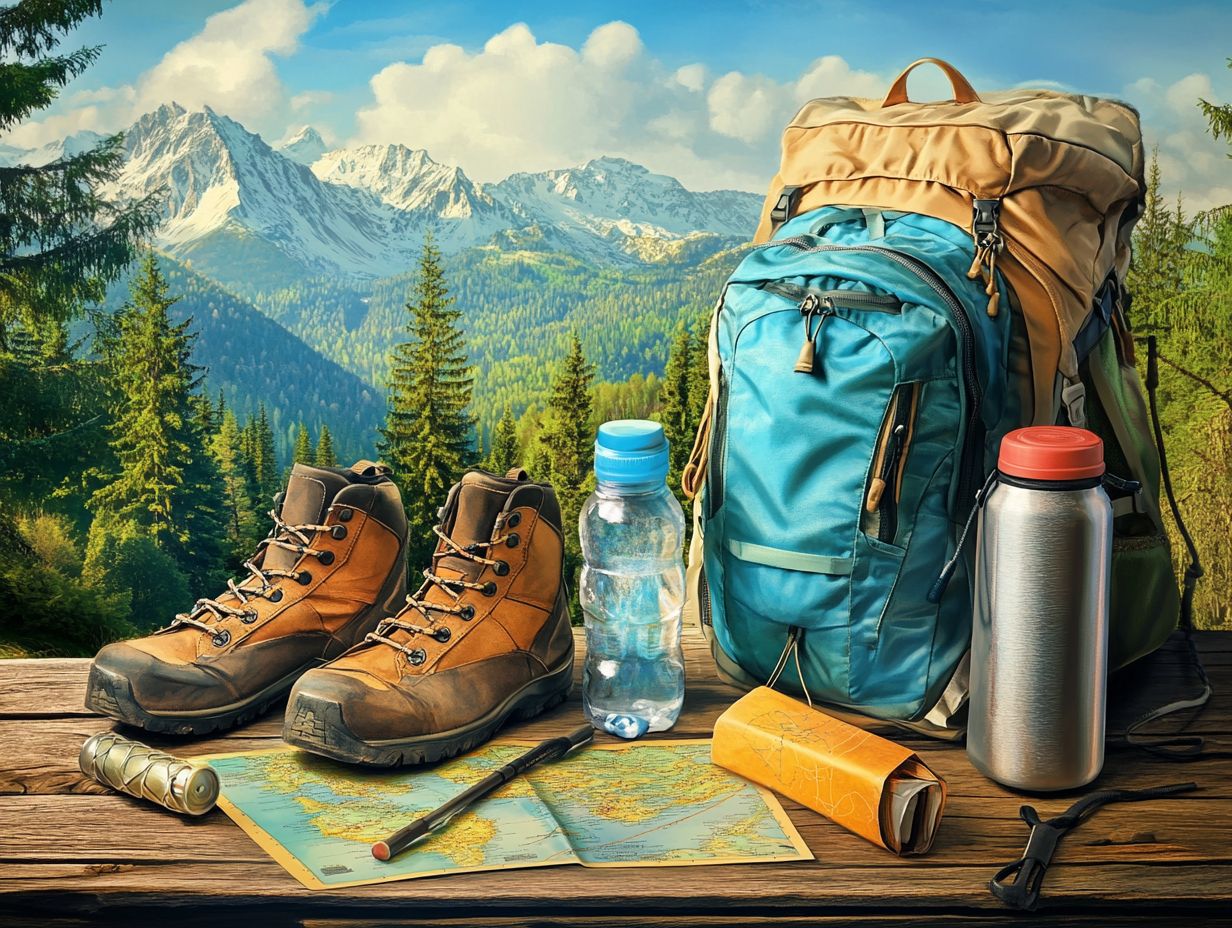
What is the best type of backpack for cross-country hiking?
Choose a lightweight, durable backpack with compartments. Look for padded straps and a waist belt for support.
Are hiking boots or trail running shoes better for cross-country hiking?
It depends on personal preference and terrain. Hiking boots offer more ankle support for rugged trails, while trail running shoes are lighter and more flexible for smoother paths.
What type of clothing is recommended for cross-country hiking?
Wear moisture-resistant and fast-drying clothing. Avoid cotton, as it takes longer to dry and can cause chafing.
How important is a good quality water bottle for cross-country hiking?
A good quality water bottle is essential. Look for a durable, leak-proof bottle with a wide mouth for easy filling and cleaning.
A map and compass are crucial for navigation. Bring a GPS device as a backup, and don t forget extra batteries.
How can I protect myself from the elements while cross-country hiking?
Prepare for changing weather by bringing a waterproof jacket, sunscreen, hat, and sunglasses. A first aid kit is also important for emergencies.

